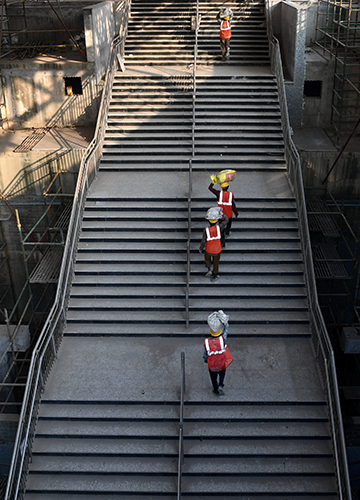The two old cities of Howrah and Kolkata, on the banks of the Hooghly, have a rich, shared history and culture. In 1943, an engineering marvel helped link the two—the Howrah Bridge, later renamed the Rabindra Setu after Rabindranath Tagore. Today, it is probably the busiest cantilever bridge in the world.
Almost 80 years later, a new link between the cities is getting ready—a metro rail through the riverbed. It will be the first underwater metro in India and is expected to start operation in early 2023. The underwater rail will connect Howrah to BBD Bagh (Dalhousie Square) in Kolkata and is part of the East-West metro project (Howrah Maidan to Sector 5, Salt Lake, Kolkata) sanctioned in 2008. This corridor is particularly significant because it has stops near the two major railway stations of Howrah and Sealdah, Kolkata. The allocation for the partially functional East-West project is Rs1,100 crore.
When Mamata Banerjee came to power in 2011, she said she would make Kolkata look like London. The chief minister is criticised for the statement even today. But, she may have hit upon an apt parallel! After all, Calcutta was capital of British India and now Kolkata has architectural similarities to London, which is on the banks of the Thames. Moreover, Howrah has often been called the Sheffield of the east for its engineering acumen.
When I visited the underwater metro tunnels, I got gooseflesh—I was standing in the middle of the riverbed taking pictures while the Hooghly flowed above. I have been travelling from Howrah to Kolkata all these years by bus, taxi, train or steamer. I never imagined that a day would come when I would travel under water.
As per the Kolkata Metro Rail Corportation (KMRC), the Howrah metro station will be the deepest metro station in the country, 33 metres under ground. The Hauz Khas metro station in New Delhi, with a depth of 29 metres, currently has this distinction. One has to descend 267 steps to reach the platform level, which will have 26 escalators, seven lifts and double-discharge facility (passengers can board or alight from both sides). The Hooghly river is 225 metres from the station.
The underwater tunnels—two of them—are 520m long. Special heat-proof train tracks have been brought from Austria. (For the entire East-West project, about 1,600 tonnes of rail tracks have been imported.) There is a ventilation and evacuation shaft along the centre of the tunnels. The 44-metre shaft opens on to Kolkata’s Strand Road and is reinforced using the sophisticated ‘New Austrian’ tunnelling method.
It was in 1972 that prime minister Indira Gandhi laid the foundation stone for India's first metro rail in Calcutta. Tapan Nath, one of the first motormen of the KMRC, remembers the first journey in 1984. “People, overwhelmed by curiosity, had so overcrowded the station that in the ensuing chaos the train could not depart on time,” said Nath.
Much has changed in Kolkata since then because of rapid urbanisation. But, there is still a lot of excitement for the underwater rail. And, this new engineering marvel is sure to become another icon for the twin-cities.


